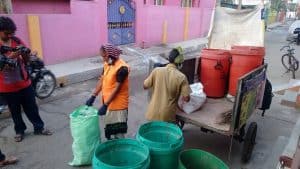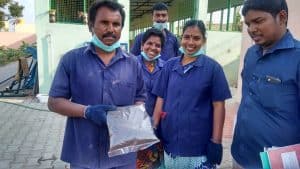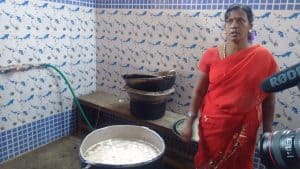The greatest challenge today before Indian cities, smart or not, is garbage. Walk through any neighbourhood in a big city and if you don’t spot at least one public bin overflowing with mixed waste, or mounds of the same dumped on the sidewalks or streets themselves, you are mighty impressed. And so I was when I recently spent a few hours in Manali, to understand the work being done by zonal officers and conservancy workers in the area.
Chennai North is made up of five zones – Tiruvottiyur, Manali, Madhavaram, Tondiarpet and Royapuram – spread over about 130 sq km. It is primarily industrial, and not as densely populated as Central and South Chennai. Waste management efforts were first undertaken in this part of the city about four years ago, but under the stewardship of Praveen Nair (IAS), Regional Deputy Commissioner (North), Greater Chennai Corporation, it has taken off in a big way and spread across the zones.
The secret to a clean Manali

Conservancy staff collecting waste from houses on Srinivasa Perumal Koil Street in Manali. Pic: Aarti Madhusudan
Walk through Manali and it is impossible not to notice the spotless streets and noticeably fewer dumpsters or bins. Assistant Executive Engineer, North Zone, Asokan, a man with an infectious zeal and obvious dedication to the cause, tells us that the number of bins on Manali streets have been reduced to half as the volumes of garbage coming out of households here have also gone down significantly.
What has made this possible? The primary reason has been segregation at source at the household level. 50 to 60% of households in the zone segregate waste in their homes, dividing it between organic and inorganic waste in two separate bags or bins. The residents have themselves invested in these containers and it is worth deliberating on whether the percentage of households segregating would go up if these could be sponsored. The conservancy workers collect the segregated waste as they go door to door on their tricycles in the mornings.

Workers of Division 19 at the Arulanandam Nagar Burial Ground happily display packets of compost produced at the facility. Pic: Aarti Madhusudan
The segregated organic waste thus collected is used to create compost manure, which is sold within the community. The space being used for this is a local burial ground, which is currently not used for its original purpose. The transformation that this ground has undergone is noteworthy. Not only does it have a composting facility, but also a small vegetable garden. Bamboo has been planted for its high oxygen generation capability.
The next big revelation was a visit to a bio-gas generation unit that has come up in the premises of a local municipal school. This facility collects food waste from hotels nearby, apart from other vegetable waste from local markets and shops. As the gentleman in charge explained, there is enough bio-gas being produced to cook the midday meal in the school. We actually saw eggs being boiled!

Eggs being boiled for the midday meal at Sharma Nagar School in Zone 4, using the bio-gas generated from waste. Pic: Aarti Madhusudan
When the school is closed, the facility is open to the local amma unavagams, who use the fuel for cooking. There are medicinal plants also being grown in the vicinity.
My last visit was to the vermicomposting facility that produces 500 kg of compost a month, which is sold again to nurseries and individuals.
Those who make it possible
The key to all of this has been the enthusiasm and hard work of the staff and officials, as well as the willingness of residents.
Many of the staff start work at 6 in the morning and go on till the evening. “In the initial days of the door-to-door garbage collection drive, we would pay personal visits to the houses of those who were not giving their garbage at the designated time to the conservancy workers,” recalls Asokan, who undertook many of these visits himself. “I gave people my phone number to call and complain if their garbage was not being collected, but to please refrain from throwing it on the street. Slowly the compliance rate started to improve.”
Even now, the workers go around every morning educating people about the value of segregation, how easy it is to do the same and its impact. The staff on the ground were extremely affable and interactive when we approached them. Can you imagine that they spend all day in the smelliest of spaces and still had the warmest of smiles for us as they spoke about it?
We spoke to a few residents too and they are obviously thrilled at having a clean community. “The common perception is that the people of North Chennai are not as educated as in the other parts of the city. We used this to our advantage, as we find people here are willing to listen to new ideas, and open to adopting new methods and solutions,” says Asokan.
Clearly, there is a lot to learn from Manali. As Regional Deputy Commissioner Nair told Citizen Matters Chennai, “With a little bit of effort from citizens to segregate at source it’s easily possible to scale this up across the city. Together with the engagement of the government machinery, citizens can not only ensure near-zero waste but also use the organic waste to generate many useful products such as bio-gas, compost manure etc.”